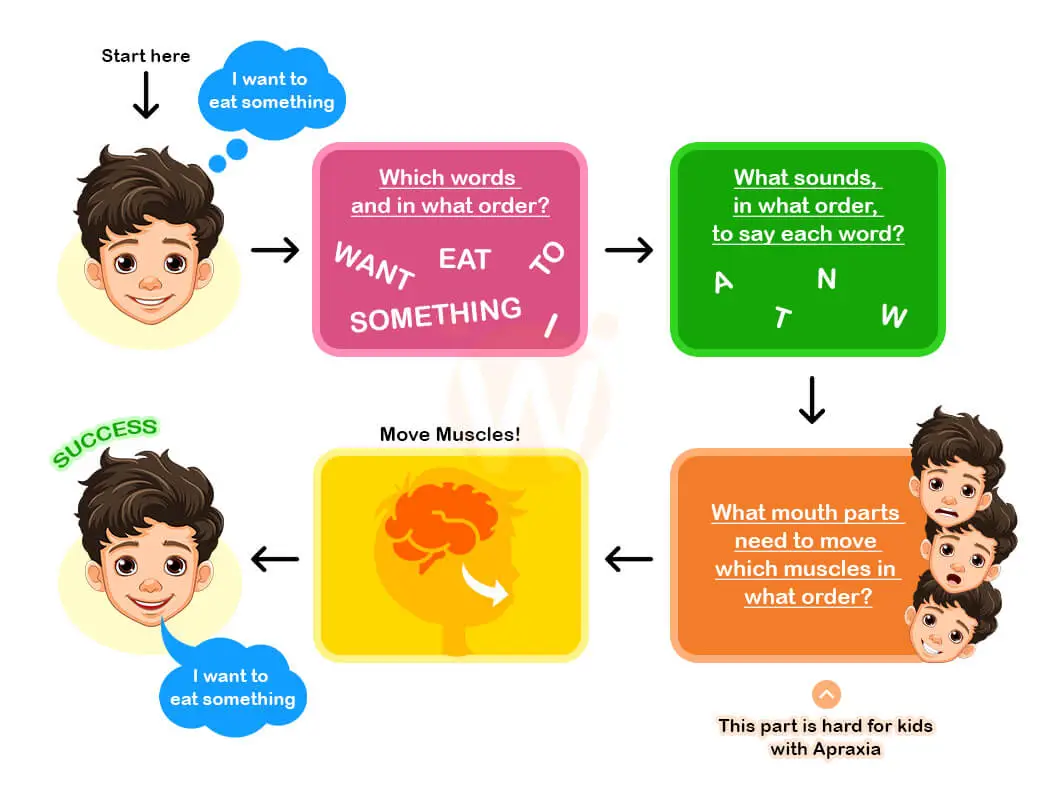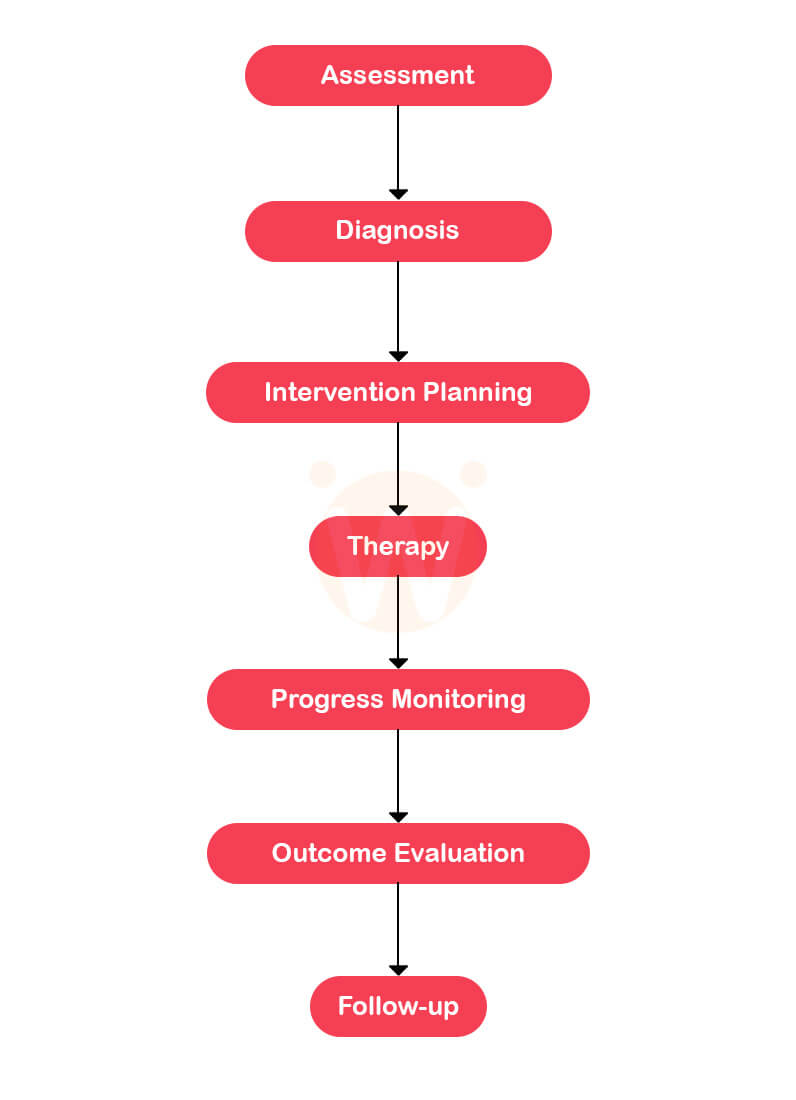Speech Therapy for Developmental Apraxia: How It Can Help Your Child
Last Updated: October 20, 2023
Developmental Apraxia of Speech (DAS), also known as Childhood Apraxia of Speech (CAS), is a motor speech disorder primarily affecting children. Unlike acquired apraxia of speech, which is caused by brain damage later in life, DAS is present from early childhood and is considered a developmental disorder. It primarily affects a child’s ability to plan and coordinate the precise movements necessary for clear speech.

Childhood Apraxia of speech or Developmental Apraxia of speech is a speech disorder in children characterized by sensorimotor problems in positioning and sequentially moving muscles for the volitional production of speech. This disorder makes it difficult for the child to coordinate the complex oral movements that are needed to produce speech sounds. Childhood Apraxia of speech or Developmental Apraxia of speech is associated with prosodic problems but is not caused by muscle weakness or neuromuscular slowness. It is presumed to be a disorder of motor programming for speech. Unlike in Apraxia of Speech (AOS) in Adults, no demonstrated neuropathology is found in Childhood Apraxia of Speech.
Characteristics of DAS
Here are some key characteristics and features of Developmental Apraxia of Speech:
- Inconsistent speech errors
Children with DAS often produce inconsistent speech errors, meaning they may have difficulty saying the same word or sound the same way each time they attempt it. - Difficulty with complex words and sequences:
DAS typically manifests as greater difficulty with longer and more complex words or phrases. Children may have particular trouble with multisyllabic words or sentences. - Slow and effortful speech:
Speech in children with DAS may be slow, effortful, and laborious as they struggle to plan and execute the correct speech movements. - Groping for sounds:
Children with DAS may appear to “grop” or struggle to find the correct tongue, lip, and jaw movements needed for speech production. They may make repeated attempts to say a word before getting it right. - Inconsistent Vowel Errors:
While consonant errors are common in DAS, vowel errors can also occur. Children may substitute, omit, or distort vowels in their speech. - Language and communication skills:
It is important to distinguish DAS from other language or cognitive disorders. Children with DAS often have intact language and cognitive abilities but struggle to express themselves verbally.
Early Onset
DAS typically becomes noticeable during the early stages of language development, usually when a child begins to speak and use more complex sounds and words. The exact cause of DAS is not always clear, but it is believed to be related to difficulties in the neural pathways responsible for speech-motor planning and execution. Some children with DAS may have a genetic predisposition, while others may have experienced neurological or developmental factors that contribute to the condition. Early diagnosis and intervention are crucial for children with DAS.
Etiology of DAS
The speech production in Childhood Apraxia of speech or Developmental Apraxia of speech involves
- No neuropathology
- Faulty speech programming
- Faulty sensory feedback mechanism
- Faulty sequencing of movements
- Faulty hierarchical movements
Childhood Apraxia of speech or Developmental Apraxia of speech has
- A higher familial incidence of speech and language disorders associated with Developmental Apraxia of speech (DAS) suggests a genetic basis
Association of DAS is found with certain syndromes, including Down syndrome and Fragile X syndrome - Childhood Apraxia of speech is more prevalent in boys than in girls
There is no significant and consistent evidence of brain lesions - General clumsiness and lack of coordination were reported in some children with DAS
- No particular personality or behavioral pattern is observed to be associated with DAS
Speech Disorders Associated
The speech disorders that are associated with DAS include
- Moderate to severe speech intelligibility problems
- Most frequent errors on consonant clusters followed by fricatives, affricates, stops, and nasals; errors on fricatives and affricates may persist longer
- Articulatory groping and silent articulatory postures
Usual errors of articulation
- More frequent occurrence of omissions and substitutions
- More prevalent distortions in some older children varied simplification of consonant blends (e.g., omission of one sound, substitution for another sound, correct production of one element, substitution of one sound for the entire cluster), voicing and devoicing errors
- Vowel and diphthong errors (distorted vowels and diphthong reduction)
Delayed speech development
- Speech production skills lag behind language comprehension skills
- Speech production skills lag behind cognitive skills
Resonance problems
- Some or most children see hypernasality, hyponasality, or nasal emission.
- Resonance problems are variable and inconsistent.
- Possibly, resonance problems due to poor velopharyngeal control and not a phonological problem
Prosodic problems
- Abnormal prosody in some cases
- Speech in some children may be aprosodic (flat prosody)
- Speech in some other children may be dysprosodic (presence of variation in frequency and duration, but inappropriate expression of them)
- Inappropriate use of stress patterns
- Fluency problems increased the frequency of dysfluences, although information on specific types and their frequencies is unavailable.
Associated Problems
Some of the associated problems with Childhood Apraxia of speech or Developmental Apraxia of speech are
- Language disorders
- Delayed language development
- Associated with delayed speech development
- Hearing impairment in some cases
- Mental retardation in some cases
- Neuromuscular disorders (e.g., cerebral palsy) in some cases
- Gross and fine visual and motor skill deficits (e.g.. problems of coordination in handwriting and typing)
- Learning disabilities
Assessment of DAS
The assessment objectives to assess the presence of Childhood Apraxia of speech or Developmental Apraxia of speech in a child are
- To assess speech production skills and speech intelligibility
- To assess language skills
- To assess other aspects of communication (voice, fluency)
- To describe the nature of a client’s speech production problems
- To make a diagnosis of DAS
- To rate or evaluate the severity of DAS
- To identify the child’s strengths and limitations
- To assess treatment potential and prognosis
- To identify initial treatment targets
Role of SLPs

Speech-language pathologists (SLPs) play a vital role in assessment and therapy for DAS. Treatment typically involves intensive speech therapy to improve speech motor planning and coordination. Therapy sessions may include various exercises, drills, and strategies tailored to the child’s needs. With consistent and targeted speech therapy, many children with DAS can significantly improve their speech production and communication skills. Family involvement and practice outside therapy sessions are also essential to support a child’s progress in overcoming DAS.
Wellness Hub offers a group of experienced and licensed Speech therapists or Speech-language pathologists (SLPs) who conduct the essential assessments to prepare therapy plans accordingly and offer therapy sessions. Our recently launched Speech Basics App offers much more to let the therapy continue even after the sessions.
Frequently Asked Question
1. What is Developmental Apraxia of Speech (DAS)?
Developmental Apraxia of Speech, also known as Childhood Apraxia of Speech (CAS), is a motor speech disorder that affects a child’s ability to plan and coordinate the movements needed for clear speech.
2. What are the key characteristics of DAS?
Children with DAS often exhibit inconsistent speech errors, difficulty with complex words and sequences, slow and effortful speech, groping for sounds, and inconsistent vowel errors.
3. How is DAS different from other speech disorders?
Unlike other speech disorders, DAS is not caused by muscle weakness or neuromuscular issues. It is a motor programming disorder where the brain has difficulty planning and coordinating the necessary movements for speech.
4. What causes Developmental Apraxia of Speech?
The exact cause of DAS is not always clear. It is believed to be related to difficulties in the neural pathways responsible for speech-motor planning and execution. There may be genetic factors, and it is sometimes associated with other syndromes like Down syndrome and Fragile X syndrome.
5. How is DAS diagnosed?
DAS is diagnosed through a comprehensive assessment by a speech-language pathologist (SLP) who evaluates the child’s speech production skills, language skills, and other aspects of communication to identify the nature and severity of the speech production problems.
6. What are the common speech errors in children with DAS?
Common speech errors include omissions and substitutions of sounds, distortions, articulatory groping, silent articulatory postures, and errors in consonant clusters, fricatives, affricates, stops, and nasals.
7. What are the associated problems with DAS?
DAS may be associated with language disorders, delayed language development, hearing impairment, mental retardation, neuromuscular disorders, visual and motor skill deficits, and learning disabilities.
8. What is the role of speech-language pathologists (SLPs) in treating DAS?
SLPs play a crucial role in assessing and treating DAS. They provide intensive speech therapy focused on improving speech motor planning and coordination through various exercises, drills, and strategies tailored to the child’s needs.
9. Can children with DAS improve their speech with therapy?
Yes, with consistent and targeted speech therapy, many children with DAS can make significant improvements in their speech production and communication skills. Family involvement and practice outside of therapy sessions are essential for progress.
10. How does Wellness Hub support children with DAS?
Wellness Hub offers experienced and licensed SLPs who conduct assessments and prepare individualized therapy plans. Additionally, the Speech Basics App provides tools and exercises to continue therapy outside of sessions, supporting ongoing progress.
About the Author:
Anuradha Karanam
Speech-language pathologist (7+ years of experience)
Anuradha Karanam is a skilled speech-language pathologist with over 6 years of experience. Fluent in Tamil, Telugu, Hindi, and English, she specializes in parent counseling, speech sound disorders, fluency assessment, and speech-language evaluations. Anuradha excels at working with children with developmental disorders, offering creative and effective therapy programs. Currently, at Wellness Hub, she holds a BASLP degree and is registered with the RCI (CRR No A85500). Her patience, ambition, and dedication make her a trusted expert.
Connect with Anuradha to learn more about how she can help you or your loved one find their voice.
Book your Free Consultation Today
Parent/Caregiver Info:
Client’s Details:
* Error Message









